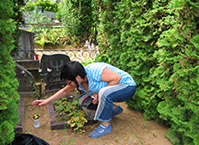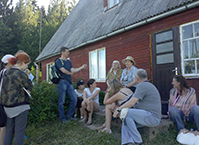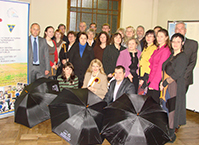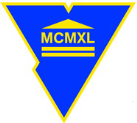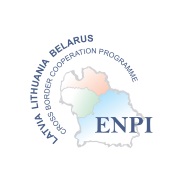E-MUSEUM “VITAMEMORIAE”: COLLECTION AND RESEARCH
Foto
To record people’s life stories, traditions, customs, rituals, rare photographs, old documents, ethnographic differences in funeral rites, etc. the researchers of Daugavpils University and Yanka Kupala Grodno State University carried out field studies in LV and BY territories: in the villages of Krāslava, Rēzekne, Daugavpils regions (Asūne, Foļvarka, Kruki, Skrudaliena, Indra, etc.) and in Belarus (Braslav and Vitebsk districts). The field studies were implemented in the framework of the project “Popularization of the Centres of Oral History in the LV – BY Cross-Border Area”, ID Nr. LLB–2–143, of the Cross Border Cooperation Programme Latvia–Lithuania–Belarus implemented within the framework of the European Neighbourhood and Partnership Instrument 2007–2013.
During the research and the expeditions, the project implementers collected, segmented, transcribed, and digitized the audio-visual materials (audio and video records, photo evidence). To make the collection of the E-Museum more complete, the field researchers and cemetery researchers of Daugavpils University and Grodno University will segment and systematize the audio-visual materials collected during oral history, cemetery research, folklore and dialectology expeditions of the previous years that until now have not been used, aiming at including the best and most valuable segments of the collection into the E-Museum.
The story tellers whose life stories make the input of the E-Museum are people of various generations, mostly elderly people. The childhood of aged people, who at present are about 80 years old, proceeded in the 1930s, therefore the segmented audio-visual units included in the E-Museum chronologically begin from 1929 and can describe only the respondents’ childhood memories. The memory of the older generation is particularly important for the anthropological and historical research – it shifts the time borders, allows for moving to the events of the past through the viewpoints of those who have experienced those times. The facts can be found in chronicles, but what the witnesses of that time can reveal give the memories colour, scent, involve one into mutual emotional experience. The witnesses of the epoch tell about the events form the viewpoint of their own experience.
To motivate the respondents to share their life stories, the project field researchers used Paul Thomson’s oral history research method – enlarged vision of social history where diverse groups of the society are brought together and share common historical experience.
The research basis is the methodology of a semi-structured interview that envisages focused (guided) reconstruction of the past events and an interviewer only helps the respondents to reconstruct the past.
The oral history collection of the E-Museum is envisaged to be used not only by specialists but also by a greatest possible range of non-specialists, therefore, departing from the academic tradition envisaging a complete script and transcript (written transcription of an audio or video record) of life stories, the project experts agreed to segment 360 most vivid, colourful, expressive, unusual, typological or extraordinary audio-visual units (photo, video and audio testimonies) – thematically complete excerpts, and to systematize them according to the thematic plan that would encompass both the historical processes of the 20th century (from the 1920s-30s) and the most essential events of an individual’s life.
ACCESSIBILITY OF THE COLLECTION
The interviews included into the collection are arranged according to the principle of historicism, anthropologism and personalia, indicating the author’s name and the interviewer’s name and surname.
-
Lev Shlyakhter: Family education
What family principles did you have? What did your parents teach you? What did they forbid? What did they permit?
I was left without parents when I was 10! I had mother.
Still you did have mother? …
Researcher: Natalia Ivashchanka, Sviatlana Silava
Categories: Family, Lev Shlyakhter
-
Beliefs, old traditions, cooking and making drinks, etc.?
About Christmas. The rooms were cleaned, the icons were decorated, people made roses and used paper to decorate the lamps, Christmas tree was brought and people decorated the tree as they could. In …
Categories: Holidays and traditions, Regina Bramane
-
About the plants
Plants at home, decorative and other plants around the farmstead in a historical aspect. What can you tell about it?
Already in my childhood, my parents’ home had a name “Lindens”, …
Researcher: Dr. philol. Valentīns Lukaševičs, Daugavpils Universitāte
Categories: Liga Seikste-Deksne
-
Were the houses decorated on Līgo [Jāņi; Midsummer night festival]?
Of course. Front door was decorated in almost every house. Well, but if Janis’ gate was not decorated, that was a great shame. For that, people teased in Līgo songs in the same way as for …
Researcher: Dr. philol. Valentīns Lukaševičs, Daugavpils Universitāte
Categories: Liga Seikste-Deksne
-
What can you tell me about wedding?
Weddings still happen, thank God, people still get married. In our area, as it has been adopted, people register their marriage at the registry office or in church, then the ushers lead them through …
Researcher: Dr. philol. Valentīns Lukaševičs, Daugavpils Universitāte
Categories: Liga Seikste-Deksne
-
What and how did people sing when they got together?
Well, the repertoire was determined by many different aspects. If they had family gatherings, neighbourhood gatherings, then the repertoire consisted largely of the Latvian folk songs. Well, let us …
Researcher: Dr. philol. Valentīns Lukaševičs, Daugavpils Universitāte
Categories: Liga Seikste-Deksne
-
What can you tell me about Shrovetide traditions?
Well, from the point of view of folklore, Shrovetide traditions are connected with masks’ activities, with disguising, with various amusements connected with masquerading. As for my childhood, …
Researcher: Dr. philol. Valentīns Lukaševičs, Daugavpils Universitāte
Categories: Liga Seikste-Deksne
-
You used to live with your grandmother. Could you characterize her a little and tell me about her views about life and her worldview?
Yes, actually, my grandmother was the only person, who had time for me in my childhood, since my parents worked – the father was a tractor driver, my mom worked with livestock, the brother was 1 …
Researcher: Dr. philol. Valentīns Lukaševičs, Daugavpils Universitāte
Categories: Liga Seikste-Deksne
-
How important are relatives and neighbours? Do such events as relatives and neighbours’ parties, get-togethers exist?
Relatives and neighbours, if you live in the country, I guess, the neighbours are even more important than the relatives, because, here we have to mention that Soviet time again, when people acquired …
Researcher: Dr. philol. Valentīns Lukaševičs, Daugavpils Universitāte
Categories: Liga Seikste-Deksne
-
Tell me, please, where you live and if the traditions of cemetery festivals (kapusvētki) are widespread in the area?
At present, the traditions may be said to be gradually disappearing. But I live in Litene civil parish of Gulbene region, it is kind of a borderland of Latgale, but the traditions typical of Vidzeme …
Researcher: Dr. philol. Valentīns Lukaševičs, Daugavpils Universitāte
Categories: Liga Seikste-Deksne


